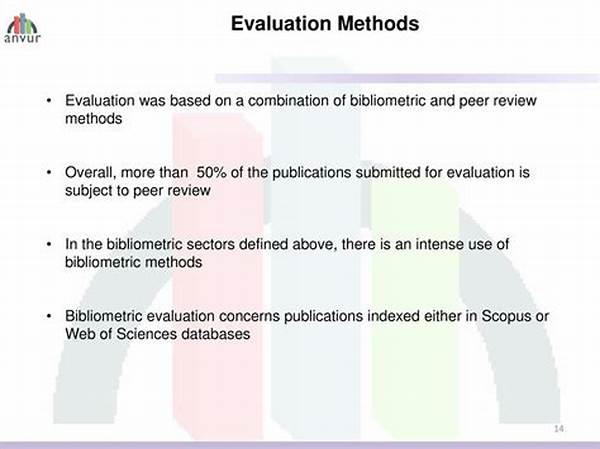In recent years, bibliometric evaluation methods have become paramount in assessing the impact and quality of scientific research. These methods offer quantitative analysis tools that aid in evaluating scholarly activities, thus providing valuable insights into research trends, prolific authors, influential journals, and institutional productivity. Bibliometric evaluation methods are primarily employed to gain an understanding of the scientific output through an array of metrics such as citation counts, h-index, and impact factor. These metrics serve as proxies to measure scholarly influence and contribution to the scientific community.
Read Now : High-performance Search Engine Development
Importance of Bibliometric Evaluation Methods
The importance of bibliometric evaluation methods lies in their ability to provide an objective framework for assessing research performance. By employing various indicators, these methods facilitate the identification of significant research contributions and emerging trends within specific fields. For universities and research institutions, implementing bibliometric evaluation methods is essential for gauging the effectiveness of research strategies and resource allocation. Furthermore, these methods enable funding agencies and policy makers to make informed decisions regarding research support and to identify which areas of research are yielding substantial scientific advancements.
Bibliometric evaluation methods are also crucial in fostering transparent and consistent evaluation practices globally. As scientific research becomes increasingly collaborative and interdisciplinary, it is imperative to have standardized metrics that transcend geographical limitations. This standardization ensures that all researchers, regardless of their locale, are subject to equitable evaluation. Ultimately, the application of bibliometric evaluation methods enhances the credibility and reliability of scholarly assessments, thereby contributing to the overall advancement of science and technology.
Components of Bibliometric Evaluation Methods
1. Citation Analysis: Bibliometric evaluation methods frequently utilize citation analysis to determine the impact of a research article based on the number of times it has been cited by others. This method serves as an indicator of the work’s influence in the field.
2. h-index Evaluation: The h-index is a key component in bibliometric evaluation methods, representing an author’s productivity and citation impact by measuring the number of publications and the number of citations per publication.
3. Impact Factor Assessment: The impact factor is a widely accepted metric within bibliometric evaluation methods, assessing the average number of citations received by articles published in a particular journal, thus reflecting its prestige and influence.
4. Co-authorship Networks: Analyzing co-authorship networks is an aspect of bibliometric evaluation methods used to understand collaboration patterns among researchers and institutions, which can enhance resource sharing and knowledge transfer.
5. Keyword Analysis: Bibliometric evaluation methods often involve keyword analysis to identify emerging themes and trends in research topics, allowing for the mapping of knowledge evolution over time.
Application of Bibliometric Evaluation Methods in Research Assessment
Bibliometric evaluation methods have increasingly been applied in research assessments to measure scientific productivity and scholarly influence across various disciplines. Their application aids institutions in prioritizing research investments, enabling them to focus on prolific areas of study that may yield impactful societal benefits. By leveraging these methods, academic institutions can also benchmark their research output against peers, facilitating a competitive yet constructive environment for scientific exploration.
Importantly, bibliometric evaluation methods help in recognizing the contributions of individual researchers and research teams. Through metrics like citation counts and h-index, researchers can demonstrate their impact within their fields, enhancing their opportunities for collaboration and funding. Moreover, by identifying key contributors within a discipline, bibliometric methods can guide efforts to build robust scientific networks, leading to more comprehensive and multidisciplinary research ventures.
Read Now : Speed Advantages In Quantum Processors
Challenges in Using Bibliometric Evaluation Methods
Despite their widespread use, bibliometric evaluation methods face several challenges. Firstly, they often rely on quantitative measures that may not fully capture the qualitative aspects of research, such as innovation and societal impact. Another challenge is the potential for over-reliance on citation metrics, which could encourage researchers to prioritize quantity over quality in their publications.
Moreover, bibliometric evaluation methods can inadvertently promote gaming the system by manipulating citation practices or prioritizing publications in high-impact journals over reputable but lesser-known ones. Addressing these challenges requires the development of more nuanced metrics that combine both quantitative and qualitative assessments to provide a comprehensive evaluation of research quality.
Future Prospects of Bibliometric Evaluation Methods
Looking forward, the evolution of bibliometric evaluation methods will be significantly influenced by advancements in digital technology and open access publishing. Innovations in data analytics and machine learning offer the potential to analyze large datasets more efficiently, thus leading to the development of more sophisticated evaluation metrics. Furthermore, the growing prevalence of open access platforms may democratize access to research findings, expanding the scope and depth of bibliometric analyses.
In the context of global scientific collaboration, future bibliometric evaluation methods may aim to incorporate cultural and contextual differences across research landscapes. This approach can enrich the interpretation of bibliometric data and provide a more inclusive framework for global research evaluation. By refining these methodologies, the scientific community can foster a more equitable and transparent evaluation process that supports the continuous advancement of knowledge.
Bibliometric Evaluation Methods: A Concluding Summary
Bibliometric evaluation methods serve as indispensable tools for assessing the impact and quality of scientific research. They offer quantitative measures that guide institutions, policymakers, and researchers in making informed decisions about research priorities and resource allocation. Despite the challenges and limitations inherent in these methods, they remain crucial in promoting a culture of rigorous scientific evaluation and accountability.
The future of bibliometric evaluation methods is promising, with opportunities for enhanced accuracy and inclusivity driven by advancements in technology and open access. By continually evolving these methods to address current limitations, the scientific community can ensure that bibliometric analysis remains a robust and effective approach to research evaluation. By fostering a more comprehensive understanding of research impact, bibliometric evaluation methods ultimately contribute to the sustainable progression of scientific inquiry and innovation.
